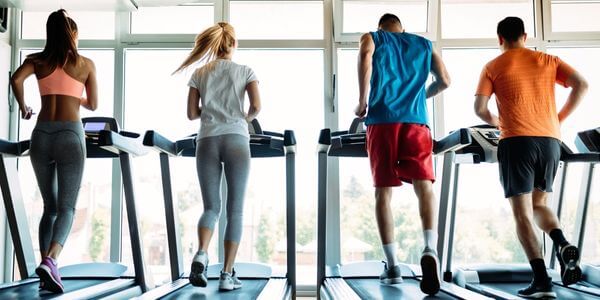Treadmill? More like trea-don’t for most people.
Seriously though, we know it’s not the most exciting workout out there. But if you’re stuck indoors, it’s a solid way to get your cardio in. Plus, it actually exercises more than just your legs – it works your whole lower body, including your glutes, hips, and…yes, your arms.
How does it do that?
We’ve put together a list of the muscles most commonly worked by treadmills, separated into three categories: running, walking, and incline. This structure will help you better understand which muscles you’re working when using this popular exercise equipment.
That’s how you can ultimately build effective workouts. And to help you get started, you can read a weekly sample workout in the conclusion section.
Keep reading below!
Table of Contents
Muscles Worked Running
Running activates your muscles differently than walking. Running at no incline is also different from using the treadmill’s tilt.
So in this section, we’ll refer to running at zero incline.
In this case, your muscles must execute more explosive movements, leading to:
- More pressure on your bones and joints
- Faster movement of your muscles
- More energy expended
- Less control over resistance-like movements
Here’s what that means for your muscles worked:
Muscles in Your Soles and Ankles
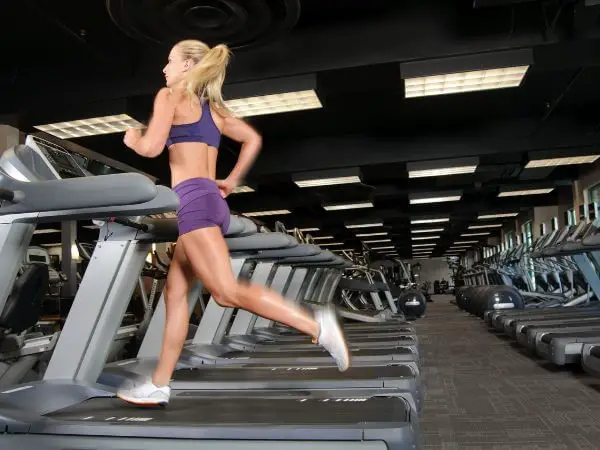
The soles of your feet are essential, even if you don’t realize that. Nobody actively goes to the gym to work out their soles or thinks about their socks as pump covers.
However:
- Strong soles and ankles stabilize your gait.
- Weak muscles in these areas lead to unbalances in your hips, hunching, and a myriad of other health issues. As a result, you’ll suffer from chronic back, neck, and hip pain.
Running will activate the muscles in these areas because they must work to stabilize your body with each step. Here are the primary muscles worked:
- Extensor hallucis longus
- Tibialis anterior
- Flexor digitorum longus
- Gastrocnemius
- Soleus
- Plantarflexors
- Dorsiflexors
- Evertors
- Invertors
Muscles in Your Calves
Your calves are some of the most important muscles when running. That’s because they work to push your body forward and up with each step.
The main muscle worked in your calves is the gastrocnemius. This muscle is responsible for plantarflexion, which is the movement that points your toes downward.
The gastrocnemius is a two-part muscle, with the inner portion (medial head) and the outer part (lateral head) working together. The medial head is responsible for plantarflexion, while the lateral head works to stabilize your ankle.
Muscles in Your Thighs
Your thighs are some of the largest muscles in your body, so it’s no surprise they’re worked when running.
- The primary muscle worked in your thighs is the quadriceps. This muscle is responsible for extending your knee, which is necessary for running. The quadriceps is a four-part muscle, with each portion working together to extend the knee. These portions are the rectus femoris, vastus lateralis, vastus medialis, and vastus intermedius.
- Running also engages your hamstrings because these muscles elongate and stabilize your leg with each exploding forward movement. However, if you’re running at zero incline, your quads will work harder than your hamstrings.
- Running activates your outer and inner thighs, but not as much as quads. These muscles are part of your thighs but act as supporting muscle groups while running. Although they elongate and contract with each step, they will do less work than your quads.
Muscles in Your Butt
Everyone wants to know if running will give them a better-looking butt. Of course, that means different things to different people. Some like bigger bums; others wish for smaller and tighter buttocks.
Here’s the deal:
Running will activate your glutes, but you won’t feel the burn as much as with incline walking/running. The reason is running has you moving faster instead of consciously, actively placing resistance on your bum.
And that resistance is what makes your glutes grow.
Muscles in Your Back
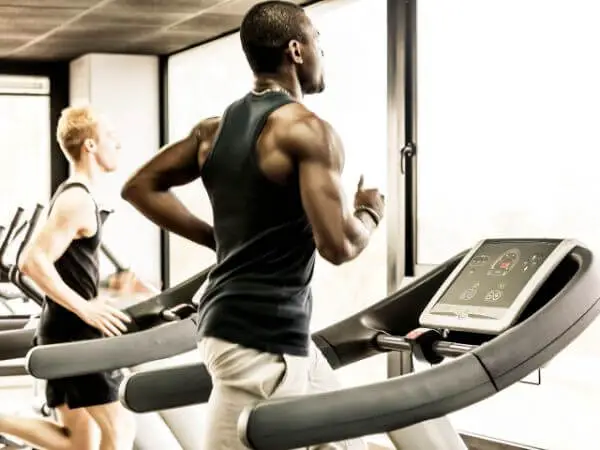
You use your back muscles when running, even though you might not feel it. These muscles work to stabilize your spine and prevent excessive movement.
- The main muscle worked in your back is the erector spinae. This muscle is responsible for keeping your spine upright and stable. The erector spinae is a three-part muscle, with each part working to stabilize a different section of your spine. These parts are the iliocostalis, longissimus, and spinalis.
- You also use the gluteus medius and gluteus minimus. These muscles in your rear stabilize your pelvis and hips while running.
Muscles in Your Chest
Your chest muscles don’t do much when running. However, they are engaged to a small degree to keep your shoulders and arms stable.
- The primary muscle worked in your chest is the pectoralis major. This muscle is responsible for keeping your shoulders down and stabilizing your arm movement. The pectoralis major is a two-part muscle, with each part working to stabilize a different section of your shoulder. These parts are the clavicular head and the sternocostal head.
- You also use the trapezius and latissimus dorsi. These muscles in your upper back stabilize your shoulders.
Don’t let that discourage you, though. There’s a way (well, three ways) to get more work out of your chest muscles when you’re running:
- Keep your posture strong, squeezing your pecs, lats, and arms. That way, these muscles stay contracted and grow stronger.
- You can also run with small free weights in your hands. However, we don’t recommend more than 1-2 pounds, or your shoulders may overstretch forwards, and you may be injured. It’s also crucial not to bend your wrists when you’re holding these weights, or again, you may hurt those wrists.
- Use wrist weights that wrap around your wrists. That way, you avoid over-squeezing your fingers and injuring your wrists. You still have to be careful not to flail your shoulders or squeeze them up to your ears.
Muscles in Your Arms
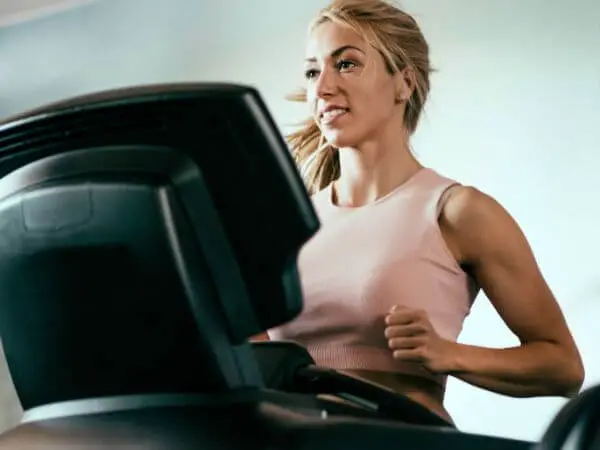
Your arms don’t do much when running, but they are engaged to a small degree to help you maintain balance.
- The primary muscle worked in your arms is the biceps brachii. This muscle is responsible for keeping your elbows stable and helping you maintain balance. The biceps brachii is a two-part muscle, with each part working to stabilize a different section of your elbow. These parts are the short head and the long head.
- You also use the deltoids and triceps brachii. These muscles in your shoulders stabilize your arms.
Again, don’t let that discourage you. You can build more arm strength while running if you:
- Keep your posture strong, squeezing your biceps and triceps.
- Hold onto free weights or use wrist weights.
Muscles in Your Core
Your core muscles are engaged to a small degree when running. These muscles work to stabilize your spine and pelvis.
The main muscle worked in your core is the rectus abdominis.
This muscle is responsible for keeping your spine stable and your pelvis level. The rectus abdominis is a two-part muscle, with each part working to stabilize a different section of your spine. These parts are the upper abs and the lower abs.
You can feel quite a burn in your abs after a good run (that’s why many newbies get runner’s diarrhea if they push themselves too much). To increase that burn, remember to keep:
- Your posture straight
- Your abs contracted
Bonus: How to get more work from your obliques
While your obliques are supporting muscles during your run, you can push them to work harder. The secret is keeping them contracted and letting your torso twist more.
Warning: Keep your hips straight forward to avoid injury, and don’t flail your shoulder or arms around.
Muscles Worked Walking
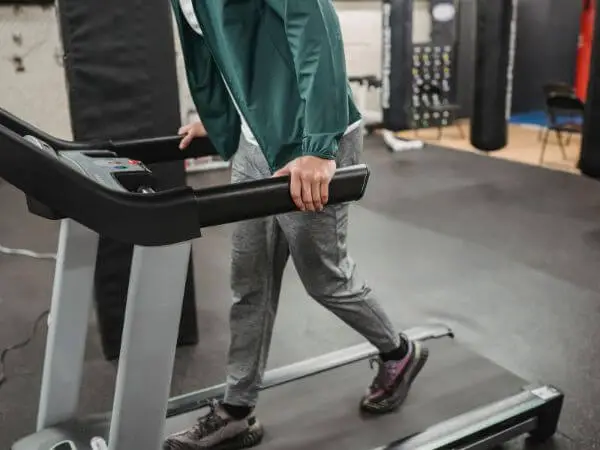
Walking shouldn’t be dismissed as running’s poorer relative. Walking has a slew of health benefits and can sometimes tone your muscles better than running.
That’s because walking has a secret weapon:
It’s intentional.
Running consists of explosive, fast movements, but walking is something you can control easier. That means you can:
- Contract your muscles without squeezing too hard.
- Avoid injury because there’s less flailing.
- Use heavier weights.
- Use resistance bands (your treadmill must come with these upper body resistance bands, or you can attach separate ones).
Muscles in Your Soles and Ankles
Walking is gentler on your soles and ankles but still gives them good work, thanks to the repetitive motion of the feet striking the ground. This impact helps strengthen the muscles and bones in the feet and improve joint function.
Additionally, walking increases blood flow to the feet, which can aid in healing and recovery.
Muscles in Your Calves
When you walk (or run), your calf muscles contract to help push your foot down and propel you forward. That back-and-forth motion strengthens your calves – and treadmill walking is no different. As long as the belt moves beneath your feet, your calf muscles will continue to contract and release.
But here’s the thing:
Running activates your calves more than walking at, say, 3 mph. However, you can sculpt those muscles better through walking if you:
- Wear a weighted vest.
- Walk at an incline.
- Keep your calves contracted.
- Alternate intervals of normal walking with intervals of walking on your tippy-toes and intervals of walking on your heels.
Muscles in Your Thighs
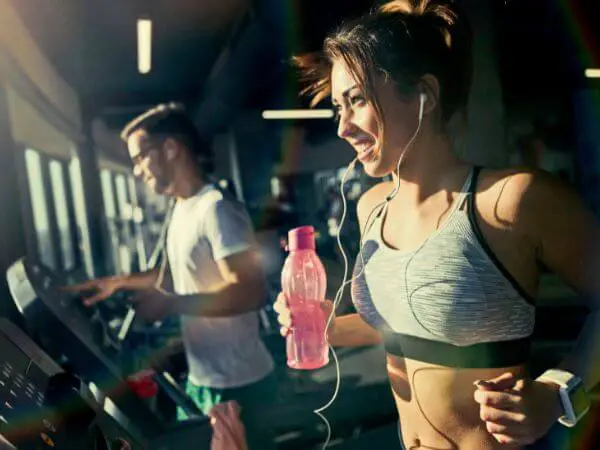
Running impacts your quads (and arguably) hamstrings more than walking. However, walking has some advantages:
- You can wear a heavier weighted vest or carry heavier free weights because you have more control over them. Therefore, you can sculpt your hamstrings and quads without the impact of running.
- You have more options to target your thigh muscles from all directions. For example, you can try walking backwards for your hamstrings or sideways to increase strength in your inner and outer thighs.
Muscles in Your Butt
Your butt comprises three main muscles: the gluteus maximus, medius, and minimus. All three are worked when you walk (or run), but they’re recruited differently depending on your speed.
- The gluteus maximus is the biggest muscle in your butt, and it’s primarily used for hip extension (think: when your leg swings back behind you). This muscle is recruited more when you walk at a faster pace.
- The gluteus medius and minimus are smaller muscles that attach to the side of your pelvis. These muscles are primarily used for stabilizing your hips and keeping them level as you walk (or run). Therefore, they’re recruited more when you walk at a slower pace because there’s more time for your hips to sway from side to side.
Try walking at different speeds and inclines to target all three muscles in your butt. You can also consider wearing a weighted vest or carrying free weights close to your chest.
Pro tip: That last point will also give your biceps a better workout!
Muscles in Your Back
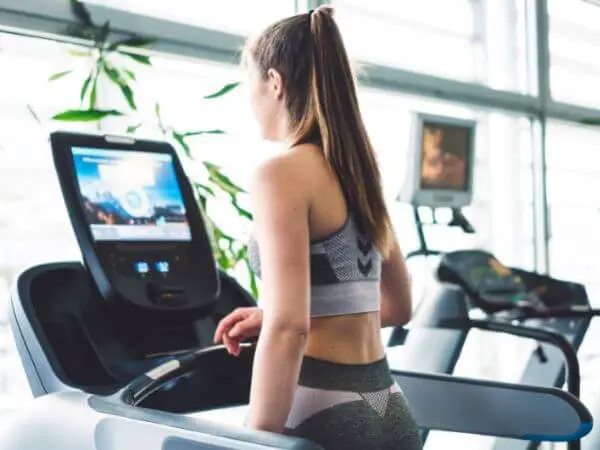
When you walk, your body weight is distributed evenly between your feet, which helps tone the muscles in your legs and buttocks. However, your body weight is no longer distributed evenly when you walk on the treadmill.
Instead, most of your weight is borne by your front leg, putting more stress on the muscles in your back. As a result, walking on the treadmill is an excellent way to exercise those back muscles. In addition, walking on the treadmill also improves your posture and prevents back pain.
Need more back work?
Keep your back muscles contracted and incorporate intervals of twisting from left to right.
Muscles in your Chest
When you walk on a treadmill, your body has to work harder to keep itself upright. Therefore, your chest muscles must contract slightly to keep you from toppling. So while walking on a treadmill may not be the most effective way to exercise your chest muscles, you still have options:
- Use the treadmill’s upper body resistance bands for rowing.
- Hold onto heavier weights while walking.
Muscles in Your Arms
Walking on a treadmill exercises the muscles in your arms when you hold onto the handrails to keep yourself upright. As a result, you get a bit of an arm workout.
But walking exercises your arm muscles more than running because you can do more upper-body-targeted exercises at a slow pace.
For example, you can set your speed at 2-3 mph and do bicep curls, tricep kickbacks, overhead presses, and more. By comparison, doing all those movements during a run increases your risk of injury, especially if you’re using heavier weights.
Muscles in Your Core
While the treadmill may not be the best way to target your abs, it indirectly works your abdominal muscles. The reason is that walking (or running) on a treadmill challenges your balance and forces your body to engage your core muscles to stay upright.
To further engage your core muscles while walking on a treadmill, try these tips:
- Add an incline to your walk.
- Wear a weight vest or hold onto dumbbells.
- Do intervals of walking and running.
- Use the treadmill’s resistance bands for exercises like chest presses, rows, and tricep extensions.
Contract your abs intentionally and start twisting with every step to engage your entire core (obliques and rectus abdominis included!)
Muscles Worked with Incline
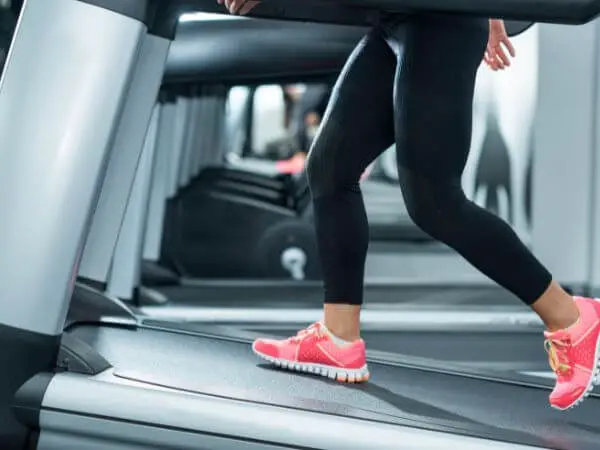
Using the incline function may be a game-changer during your treadmill workout because it activates your muscles more than walking on a flat surface.
We won’t reiterate all those muscle groups for the third time. However, we’ll explain why an incline adds more resistance to your muscles, therefore pushing them harder:
Here’s how it works:
- Lower body. When you use the incline, your body has to work harder to move against gravity. Therefore, all the muscles in your legs (including your quads, hamstrings, glutes, and calves) must contract more forcefully to lift your body up the incline.
- Upper body. Using the incline engages your arm muscles more because you have to use them to support your body weight as you walk uphill.
- Core. The incline also works your core muscles more because they contract harder to keep you stable as you walk at an angle.
If you want a killer full-body workout, try walking on an incline for 30 minutes at a moderate pace. Just be sure to warm up first and cool down afterwards!
Wrap Up + Weekly Workout Routine
Now that you know how walking on the treadmill works your muscles, you have a better idea of the workouts you need. You also know which treadmill may suit you better.
For example, we recommend this routine:
- Monday: HIIT running workout. After your warm-up, do a 40-second running interval at your maximum speed with no incline, followed by a 40-second running interval at your top speed with the treadmill’s moderate incline. Then, do two 40-second walking intervals and repeat the scheme for ten to thirty minutes. Don’t push yourself more than that, especially if you’re a newbie.
- Tuesday: Slow walking plus upper body strength training.
- Wednesday: Steady-state cardio day; either jog/walk at a comfortable speed (say 4-5 mph or whatever you’re okay with) or walk at an incline. If you’re too sore, take a rest day.
- Thursday: Repeat slow walking plus upper body strength training
- Friday: HIIT running workout
- Saturday: Active rest day; slow walking followed by Yoga/ a more extended stretching session
- Sunday: Optional rest day or slow walking followed by a more extended stretching session
- 7 Exercises for Pregnant Women in the First Trimester: Safe and Effective - January 30, 2025
- Our equipment recommendations - October 30, 2024
- Here’s What Doing Cardio Every Day Does To Your Body - August 21, 2024

